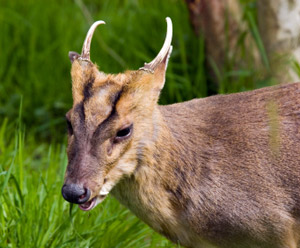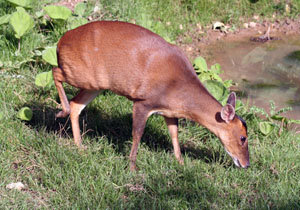Deer populations – the muntjac menace

Muntjac deer ("Muntiacus reeves") are small but they reproduce quickly. They are fast becoming a major threat to wildlife. Because they tend not to eat agricultural crops, they are not controlled by farmers so they are in danger of 'eating out' the floors of English deciduous woodlands - which are so important to biodiversity. These deer were originally introduced into this country by mistake after they escaped from Woburn Safari park in about 1925, and since then they have spread through most of England but are concentrated south of the M62 motorway (Hull to Manchester).
Also know as Chinese Muntjac, these deer grow only to only about two feet tall and weigh 10-16 kg. They live about 15 years but the secret of their success in colonisation is their breeding pattern: they have no set breeding season and the females are fertile after only 8 months - while the gestation time is 7 months.
The core of the muntjac problem is that for shooters they are hard to spot and in deer-stalking terms it is hardly worthwhile shooting them because of the small amount of meat on each animal. This contrasts with the native deer - roe and red deer - and even with the other introduced species such as sika and Chinese water deer. Numbers are hard to ascertain as they are nocturnal and much more inclined to hide than other uk deer. What is know from surveys is that they have spread to Wales and Ireland in recent years.
Many people first become aware of muntjac in their area because they make a barking sound, plus they also like grazing in residential gardens. Their small size also enables them to get through gaps and fences that larger deer species cannot pass through. There is a short clip of muntjac here where you can also hear the barking:
http://www.bbc.co.uk/blogs/walesnature/2008/10/the_barking_deer.html
 The Forestry Commission are very concerned about the damage that Muntjac are doing: Karl Ivens of the FC said: “We have beautiful bluebell woods, but 20 years ago they were much better. It’s just that, over time, the damage is not noticed. The impact the deer have on flora and fauna is huge. Unfortunately, we are planting a lot more palatable species for them. They like to eat broad-leaved trees." The Forestry Commission has a policy of culling them wherever possible to encourage the native roe deer.
The Forestry Commission are very concerned about the damage that Muntjac are doing: Karl Ivens of the FC said: “We have beautiful bluebell woods, but 20 years ago they were much better. It’s just that, over time, the damage is not noticed. The impact the deer have on flora and fauna is huge. Unfortunately, we are planting a lot more palatable species for them. They like to eat broad-leaved trees." The Forestry Commission has a policy of culling them wherever possible to encourage the native roe deer.
Unfortunately, Muntjac are liked by the public who see them as "bambi-like". They are easy to recognise as they are about the size of dogs and because of their long back legs they have a rounded back end so that they are almost pig-like, and unlike many other deer species they tend to be found in pairs rather than in small herds. Hopefully through coordinated efforts, the muntjac population can be reduced. There are apparently more deer in the UK now than at any time since the war.
Comments are closed for this post.
